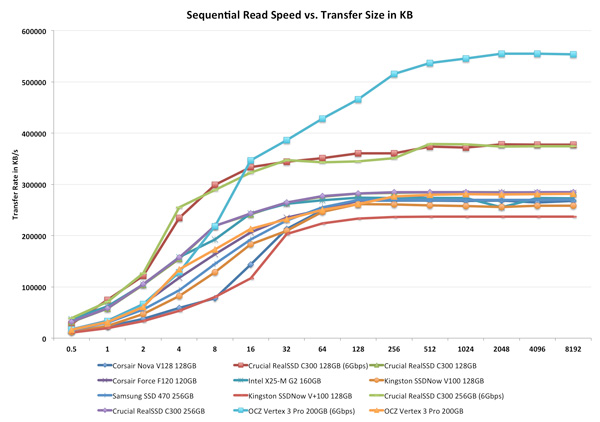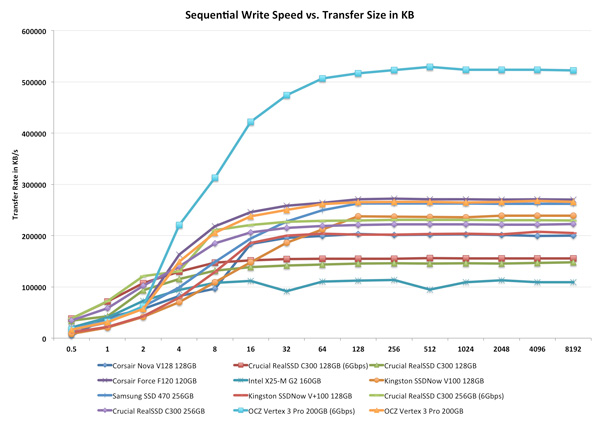OCZ Vertex 3 Pro Preview: The First SF-2500 SSD
by Anand Lal Shimpi on February 17, 2011 3:01 AM ESTPerformance vs. Transfer Size
All of our Iometer sequential tests happen at a queue depth of 1, which is indicative of a light desktop workload. It isn't too far fetched to see much higher queue depths on the desktop. The performance of these SSDs also greatly varies based on the size of the transfer. For this next test we turn to ATTO and run a sequential write over a 2GB span of LBAs at a queue depth of 4 and varying the size of the transfers.
On a 6Gbps SATA port the Vertex 3 Pro is unstoppable. For transfer sizes below 16KB it's actually a bit average, and definitely slower than the RealSSD C300. But once you hit 16KB and above, the performance is earth shattering. The gap at 128KB isn't even as big as it gets, we don't see leveling off of performance until 2048KB transfers.
The 3Gbps performance is pretty unimpressive. In fact, the Vertex 3 Pro actually comes in a bit slower than the SF-1200 based Corsair Force F120. If you're going to get the most out of this drive you had better have a good 6Gbps controller.
ATTO's writes are fully compressible, indicative of the sort of performance you'd get on applications/libraries/user data and not highly compressed multimedia files. Here the advantage is just hilarious. By the 8KB mark the Vertex 3 Pro is already faster than everything else, but by 128KB the gap is more of a chasm separating the 6Gbps Vertex 3 Pro from its competitors.
Over a 3Gbps interface the Vertex 3 Pro once again does well but still doesn't really differentiate itself from the SF-1200 based Force F120. Real world performance is probably a bit higher as most transfers aren't perfectly compressible, but again if you don't have a good 6Gbps interface (think Intel 6-series or AMD 8-series) then you probably should wait and upgrade your motherboard first.












144 Comments
View All Comments
PubicTheHare - Thursday, February 17, 2011 - link
Anand,Would this be the drive to pair with a Sandy Bridge Macbook Pro, or do we still need to wait for native TRIM support in OSX?
I'm really eager to buy a Sandy Bridge MBP and do this if the V3P is the one to get. I can't recall which controller you recommended for Macs.
markjx1 - Thursday, February 17, 2011 - link
Why no mention of the fact this was originally slated for the SF-2000, and now its got the enterprise class SF-2500 with disclaimers of "hardware not final" all over the article?The truth is they had major problems with SF-2000 and nobody wants to talk about it - of all people I'd think you would have. Now go ahead and delete my post again.
markjx1 - Thursday, February 17, 2011 - link
Resorting to using the enterprise-class SF-2500 means I worry about cost competitiveness against other upcoming Gen3 offerings from Intel and Crucial/Micron.OCZ took a $25 mil bank loan recently so they need a winner. I worry about the "hardware is not final" disclaimers in the article. Sending these samples out for some buzz smells like buying time while they work out production dilemmas since originally they were going to use a different SF controller.
bplewis24 - Friday, February 18, 2011 - link
Why are you trolling? You have 3 of essentially the same posts on this page. We get it, you think he "sold out" for not mentioning that it's using a different controller.Brandon
vol7ron - Thursday, February 17, 2011 - link
Does this mean a higher QD, might improve performance.It looks like QD of 16 might be the sweet spot in terms of latency vs IOPS
DJMiggy - Thursday, February 17, 2011 - link
Thanks for the great article and thank you OCZ for making my Vertex 1 even more obsolete. That's ok though! Not a complaint! lol Just looking forward to my next upgrade!Rasterman - Thursday, February 17, 2011 - link
Since the drive is 400MB/s read, if you use two in RAID-0 are you going to get 800MB/s or the realistic max of 6gpbs of ~700MB/s?If you use RAID-0 X4 are you going to get 1600MB/s or ~700MB/s?
jwilliams4200 - Thursday, February 17, 2011 - link
With a decent RAID card, then RAID 0 of N drives will give you slightly less than N times the performance of a single drive.For on-motherboard RAID, you will also get approximately N times the performance of a single drive, but there is usually a ceiling to total performance on motherboard RAID. It is around 600 MB/s for ICHR-10.
myterrybear - Thursday, February 17, 2011 - link
I've been a loyal reader of this sight, but what realy myths me if you's use EVERY other controler but those found on the AMD platform .... especialy more so with a Sata 6.0 SSD like this it would match up well for those of us amd users whom have paid money to upgrade the motherboard to have that sb8xx controler onboard to utilize hard drives & other devices that run on the now becoming Sata 6.0 standard.Per Hansson - Thursday, February 17, 2011 - link
Hi, has the much talked about hibernation problem with the Sandforce drives been solved in the 2xxx series?Loosing Hibernation is pretty much a deal killer for me in a laptop :(
http://www.google.se/search?hl=sv&safe=off&...